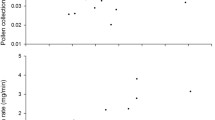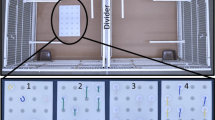Abstract
Animals use cues from a range of sensory modalities to discriminate stimuli and as predictors of reward. Whilst there is appreciable variation in the cognitive performance of animals, we know surprisingly little about the extent to which learning varies among individuals across different sensory modalities. Do individuals that are good at learning in one sensory modality also perform well in another (performance is correlated between modalities), or do individuals demonstrate specialisation in learning performance in one modality (trading-off performance between modalities)? We tested these hypotheses by examining the performance of 76 Bombus terrestris workers, from four colonies, in both an odour-and visual learning task. Olfactory learning was assessed using proboscis extension reflex (PER) conditioning and visual (colour) learning was examined using a well-established free-flying paradigm. Our results showed neither a correlation, nor a trade-off, in individual performance for learning tasks using different sensory modalities. However, there was considerable variation among workers within each colony in their performance in both learning tasks. This extent of interindividual variation in learning ability across sensory modalities could be adaptive for colonies dealing with changeable foraging conditions. There was also significant intercolony variation in final task performance level in the olfactory learning task, and both the strength and persistence of blue preference in the colour learning task. This is the first study to demonstrate variation in olfactory learning performance across multiple bumblebee colonies using PER conditioning, suggesting this is an effective paradigm for assessing associative olfactory learning performance both within and among colonies.




Similar content being viewed by others
References
Biegler R, McGregor A, Krebs JR, Healy SD (2001) A larger hippocampus is associated with longer-lasting spatial memory. Proc Natl Acad Sci U S A 98:6941–6944. doi:10.1073/pnas.121034798
Bitterman ME, Menzel R, Fietz A, Schafer S (1983) Classical-conditioning of proboscis extension in honeybees (Apis mellifera). J Comp Psychol 97:107–119. doi:10.1037/0735-7036.97.2.107
Burger H, Dötterl S, Ayasse M (2010) Host-plant finding and recognition by visual and olfactory floral cues in an oligolectic bee. Funct Ecol 24:1234–1240. doi:10.1111/j.1365-2435.2010.01744.x
Burns JG, Dyer AG (2008) Diversity of speed-accuracy strategies benefits social insects. Curr Biol 18:R953–R954. doi:10.1016/j.cub.2008.08.028
Chittka L, Dyer AG, Bock F, Dornhaus A (2003) Bees trade off foraging speed for accuracy. Nature 424:388. doi:10.1038/424388a
Chittka L, Skorupski P, Raine NE (2009) Speed-accuracy tradeoffs in animal decision making. Trends Ecol Evol 24:400–407. doi:10.1016/j.tree.2009.02.010
Cole EF, Morand-Ferron J, Hinks AE, Quinn JL (2012) Cognitive ability influences reproductive life history variation in the wild. Curr Biol 22:1808–1812. doi:10.1016/j.cub.2012.07.051
Dukas R (2008) Evolutionary biology of insect learning. Annu Rev Entomol 53:145–160. doi:10.1146/annurev.ento.53.103106.093343
Giurfa M, Sandoz JC (2012) Invertebrate learning and memory: 50 years of olfactory conditioning of the proboscis extension response in honeybees. Learn Mem 19:54–66. doi:10.1101/lm.024711.111
Hagbery J, Nieh JC (2012) Individual lifetime pollen and nectar foraging preferences in bumble bees. Naturwissenschaften 99:821–832. doi:10.1007/s00114-012-0964-7
Healy SD, de Kort SR, Clayton NS (2005) The hippocampus, spatial memory and food hoarding: a puzzle revisited. Trends Ecol Evol 20:17–22. doi:10.1016/j.tree.2004.10.006
Ings TC, Raine NE, Chittka L (2009) A population comparison of the strength and persistence of innate colour preference and learning speed in the bumblebee Bombus terrestris. Behav Ecol Sociobiol 63:1207–1218. doi:10.1007/s00265-009-0731-8
Jandt JM, Bengston S, Pinter-Wollman N, Pruitt JN, Raine NE, Dornhaus A, Sih A (2014) Behavioural syndromes and social insects: personality at multiple levels. Biol Rev 89:48–67. doi:10.1111/brv.12042
Katsnelson E, Motro U, Feldman MW, Lotem A (2011) Individual-learning ability predicts social-foraging strategy in house sparrows. Proc R Soc Lond B 278:582–589. doi:10.1098/rspb.2010.1151
Kulahci IG, Dornhaus A, Papaj DR (2008) Multimodal signals enhance decision making in foraging bumble-bees. Proc R Soc Lond B 275:797–802. doi:10.1098/rspb.2007.1176
Kunze J, Gumbert A (2001) The combined effect of color and odor on flower choice behavior of bumble bees in flower mimicry systems. Behav Ecol 12:447–456. doi:10.1093/beheco/12.4.447
Laloi D, Pham-Delegue MH (2004) Bumble bees show asymmetrical discrimination between two odors in a classical conditioning procedure. J Insect Behav 17:385–396. doi:10.1023/B:JOIR.0000031538.15346.e1
Laloi D, Sandoz JC, Picard-Nizou AL, Marchesi A, Pouvreau A, Tasei JN, Poppy G, Pham-Delegue MH (1999) Olfactory conditioning of the proboscis extension in bumble bees. Entomol Exp Appl 90:123–129. doi:10.1046/j.1570-7458.1999.00430.x
Leadbeater E, Chittka L (2007) The dynamics of social learning in an insect model, the bumblebee (Bombus terrestris). Behav Ecol Sociobiol 61:1789–1796. doi:10.1007/s00265-007-0412-4
Leonard AS, Dornhaus A, Papaj DR (2011) Flowers help bees cope with uncertainty: signal detection and the function of floral complexity. J Exp Biol 214:113–121. doi:10.1242/jeb.047407
Menzel R (2012) The honeybee as a model for understanding the basis of cognition. Nat Rev Neurosci 13:758–768. doi:10.1038/nrn3357
Mery F, Kawecki TJ (2003) A fitness cost of learning ability in Drosophila melanogaster. Proc R Soc Lond B 270:2465–2469. doi:10.1098/rspb.2003.2548
Mery F, Kawecki TJ (2004) An operating cost of learning in Drosophila melanogaster. Anim Behav 68:589–598. doi:10.1016/j.anbehav.2003.12.005
Mery F, Kawecki TJ (2005) A cost of long-term memory in Drosophila. Science 308:1148. doi:10.1126/science.111131
Molet M, Chittka L, Raine NE (2009) How floral odours are learned inside the bumblebee (Bombus terrestris) nest. Naturwissenschaften 96:213–219. doi:10.1007/s00114-008-0465-x
Muller H, Chittka L (2008) Animal personalities: the advantage of diversity. Curr Biol 18:R961–R963. doi:10.1016/j.cub.2008.09.001
Muller H, Chittka L (2012) Consistent interindividual differences in discrimination performance by bumblebees in colour, shape and odour learning tasks (Hymenoptera: Apidae: Bombus terrestris). Entomol Gen 34:1–8
O’Donnell S, Clifford MR, Bulova SJ, DeLeon S, Papa C, Zahedi N (2014) A test of neuroecological predictions using paperwasp caste differences in brain structure (Hymenoptera: Vespidae). Behav Ecol and Sociobiol 68:529–536. doi:10.1007/s00265-013-1667-6
Ottoni EB (2000) EthoLog 2.2: a tool for the transcription and timing of behavior observation sessions. Behav Res Meth Ins C 32:446–449. doi:10.3758/bf03200814
R Core Team (2014) R: A language and environment for statistical computing. R Foundation for Statistical Computing, Vienna, Austria. http://www.R-project.org
Raine NE, Chittka L (2007) The adaptive significance of sensory bias in a foraging context: floral colour preferences in the bumblebee Bombus terrestris. PLoS One 2:e556. doi:10.1371/journal.pone.0000556
Raine NE, Chittka L (2008) The correlation of learning speed and natural foraging success in bumble-bees. Proc R Soc Lond B 275:803–808. doi:10.1098/rspb.2007.1652
Raine NE, Chittka L (2012) No trade-off between learning speed and associative flexibility in bumblebees: a reversal learning test with multiple colonies. PLoS One 7:e45096. doi:10.1371/journal.pone.0045096
Raine NE, Ings TC, Ramos-Rodriguez O, Chittka L (2006) Intercolony variation in learning performance of a wild British bumblebee population (Hymenoptera: Apidae: Bombus terrestris audax). Entomol Gen 28:241–256
Reinhard J, Srinivasan MV, Zhang SW (2006) Complex memories in honeybees: can there be more than two? J Comp Physiol A 192:409–416. doi:10.1007/s00359-005-0079-0
Riddell CE, Mallon EB (2006) Insect psychoneuroimmunology: immune response reduces learning in protein starved bumblebees (Bombus terrestris). Brain Behav Immun 20:135–138. doi:10.1016/j.bbi.2005.06.008
Riveros AJ, Gronenberg W (2009) Olfactory learning and memory in the bumblebee Bombus occidentalis. Naturwissenschaften 96:851–856. doi:10.1007/s00114-009-0532-y
Riveros AJ, Gronenberg W (2012) Decision-making and associative color learning in harnessed bumblebees (Bombus impatiens). Anim Cogn 15:1183–1193. doi:10.1007/s10071-012-0542-6
Saleh N, Scott AG, Bryning GP, Chittka L (2007) Distinguishing signals and cues: bumblebees use general footprints to generate adaptive behaviour at flowers and nest. Arthropod Plant Interact 1:119–127. doi:10.1007/s11829-007-9011-6
Scheiner R, Page RE, Erber J (2001a) The effects of genotype, foraging role, and sucrose responsiveness on the tactile learning performance of honey bees (Apis mellifera L.). Neurobiol Learn Mem 76:138–150. doi:10.1006/nlme.2000.3996
Scheiner R, Page RE, Erber J (2001b) Responsiveness to sucrose affects tactile and olfactory learning in preforaging honey bees of two genetic strains. Behav Brain Res 120:67–73. doi:10.1016/s0166-4328(00)00359-4
Snell-Rood EC, Papaj DR (2009) Patterns of phenotypic plasticity in common and rare environments: a study of host use and color learning in the cabbage white butterfly Pieris rapae. Am Nat 173:615–631. doi:10.1086/597609
Sommerlandt FMJ, Rossler W, Spaethe J (2014) Elemental and non-elemental olfactory learning using PER conditioning in the bumblebee, Bombus terrestris. Apidologie 45:106–115. doi:10.1007/s13592-013-0227-4
Takeda K (1961) Classical conditioned response in the honey bee. J Insect Physiol 6:168–179
Toda NRT, Song J, Nieh JC (2009) Bumblebees exhibit the memory spacing effect. Naturwissenschaften 96:1185–1191. doi:10.1007/s00114-009-0582-1
Acknowledgments
We thank Mark Brown, Gemma Baron, Lisa Evans and Dara Stanley for the comments and Oscar Ramos-Rodriguez for the technical assistance, Syngenta Bioline Bees for supplying the colonies and Andre Riveros for the helpful advice about PER with bumblebees. KES was supported by a Crosslands Research Scholarship and the Atkins bequest from Royal Holloway University of London.
Author Contributions
KES carried-out the experiment and statistical analyses, KES & NER conceived the project, designed the experiment and wrote the paper.
Author information
Authors and Affiliations
Corresponding author
Additional information
Communicated by M. Giurfa
Electronic supplementary material
Below is the link to the electronic supplementary material.
ESM 1
(DOCX 83 kb)
Rights and permissions
About this article
Cite this article
Smith, K.E., Raine, N.E. A comparison of visual and olfactory learning performance in the bumblebee Bombus terrestris . Behav Ecol Sociobiol 68, 1549–1559 (2014). https://doi.org/10.1007/s00265-014-1765-0
Received:
Revised:
Accepted:
Published:
Issue Date:
DOI: https://doi.org/10.1007/s00265-014-1765-0




